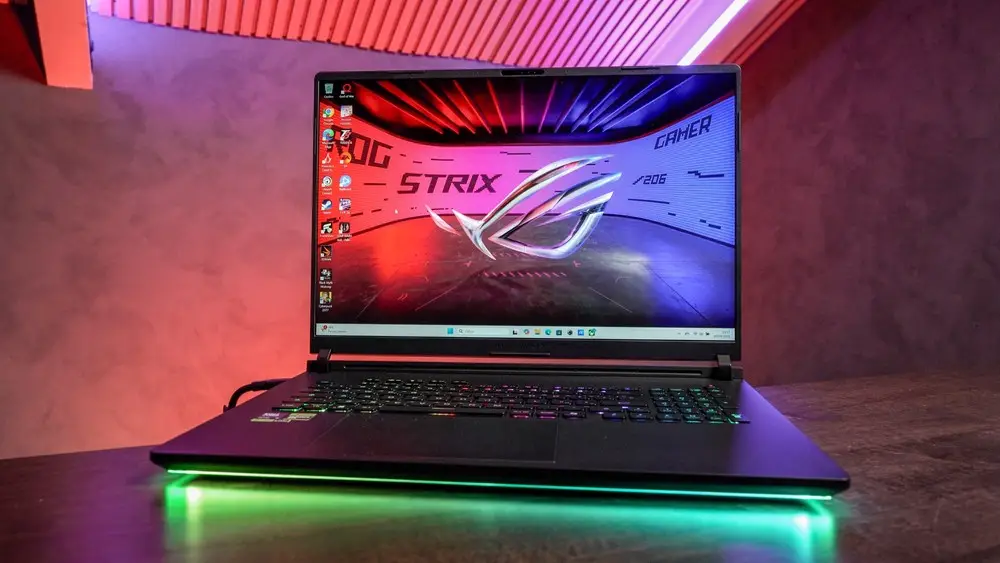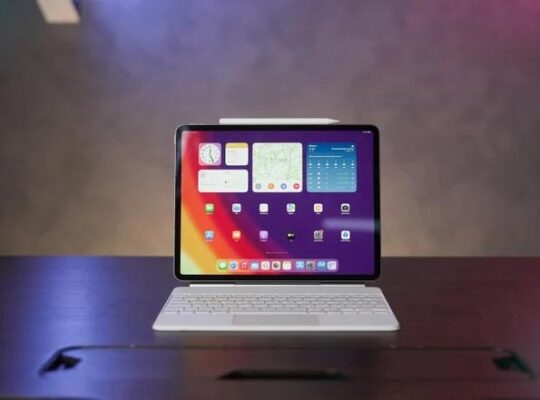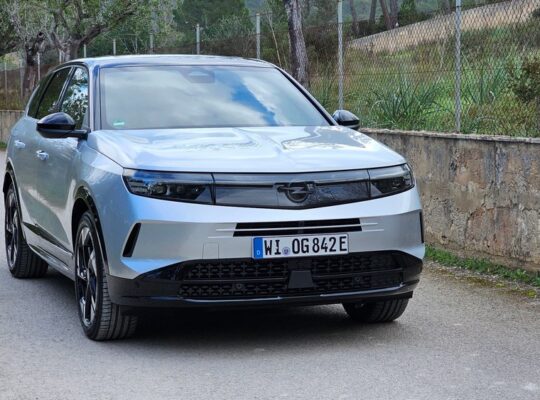Although it is Asus’s most outstanding gaming laptop, ROG Strix Scar 18 is also the most bold, strong, and radical in its design. Asus updates its top oft he line Scar family in 2025 with the model known by the acronym G835, which brings out the new Intel Arrow Lake CPUs, the Nvidia RTX 5000 series GPUs, and a thoroughly refreshed cooling mechanism. A machine created to meet the most exacting players with first-class performance, even if it compromises other features including portability. Just as is the case with gaming notebooks, in reality this Strix Scar 18 2025 is something more transportable than portable. This is actually then a product Still, let me go over it in depth here in this review. ROG Stix Scar.
Design, materials, and implementation

ROG Strix Scar 18 Edition 2025 shows a major change in design philosophy, if not predominantly in hardware as well. In favor of a more basic, practical, and mature design, Asus has left behind, at least in part, the “aggressive gaming” image that defined past generations.
Apart from the metal cover, which offers little structural integrity and enhances the general subjective impression, the body is mostly made of stiff plastic. Given the premium positioning of the product, the decision to keep plastic for the whole keyboard area and palm rest is suspect; then again, we know that using a metal alloy for the whole body would have even more risen the weight. Compared to the past, Asus has enhanced the finishing: the interior surface is somewhat rubberized and matte, gentle to the touch and not very scratch resistant but very sensitive to fingerprint and skin oil.

From an aesthetic standpoint Asus has clearly moved toward more sobriety. Gone are the semitransparent surfaces, overstated logos, and futuristic silkscreens found on the 2023 models. With strict lines and no extraneous visual components, the new Scar 18 sports a monolithic appearance: flat black, angular. Inherited from the Zephyrus range, the only “scenic” element is the Anime Matrix LED matrix mounted on the back of the lid. Customized images, messages, and animations may be displayed on this secondary screen. If you want a more somber appearance, know that there is a solution because it can still be deactivated. Asus has then scrapped the front light bar in favor of a new surrounding light bar running the whole lower edge of the chassis. The light is more even and more dully fitted into the design. Like on other occasions, the illumination here can be turned off with one click and thoroughly adjusted via software, so the laptop almost seems like a desktop.
Certainly not an ultraportable, the Scar 18 is over 2.5 cm thick and weighs about 3.5 kg. It should be considered in light of its announced desktop replacement. Since Asus has somewhat enlarged the dimensions in contrast to the model of 2023 to accommodate the new dissipation mechanism, so transportation will not be easy; you would need a proper backpack and a healthy amount of will.






Even though it is a good and appreciated revamp, I still saw a few aspects in need of more development in terms of ergonomics. The first is related to the front edge of the wrist rest, which has a rather sharp edge that the wrists rub against while typing; not exactly comfortable. Rather than given by the lack of notch on the top edge of the screen which Asus has removed to assist one to grasp it more effortlessly when having to raise it to launch the notebook. Here as well, it is a decision that winks at a neater and more sober appearance but that mechanically does not help at all.
Another factor that is sometimes ignored but which in my view is very pertinent in appraising a notebook is the one concerning physical connectivity. Strix Scar 18 2025 revolutionizes this feature a bit compared to the past and, in fact, moves all the ports that were previously located on the back along the two short sides of the notebook. A decision driven by the necessity to utilize the entire rear edge to enlarge the size of the hot air vent grill, therefore enhancing the notebook’s airflow.
Thus, on the two small edges we see: a new proprietary power supply connector, a 2.5 Gb LAN port, an HDMI 2.1, two USBC including a Thunderbolt 5.0, the combo audio jack and, eventually, two USBA 3.2 Gen2 ports. We are discussing a definitely complete device, but which in my view needs a memory card reader either in SD or microSD format . Certainly due to its power, this book would have been a welcome presence since material designers could also take it into account.





And I’ll finish this part by discussing the trackpad and the keyboard. In a high-end laptop like the Strix Scar 18, direct user interaction—that is, the keyboard and touchpad—is as crucial as the processor’s speed or the screen’s resolution. Particularly in feel and precision, this 2025 model provides small but major improvements. Still, some of the options in ergonomics and materials selected leave space for development.
Previous generations’ island style layout is retained on the keyboard. Though with a little compressed layout, it is a full-size keyboard with full-size arrow keys and a number pad to the right side. For those arriving from desktop keyboards, the design will be familiar but possibly it would take some getting used to. The click is sharp and clear, perhaps even too good if we have to type for a long time; the movement is deep, nearly 2mm. Assuming this is a keyboard that properly leans more toward gaming than productivity.
In terms of size, the touchpad is large with a glass surface, multitouch and totally supports system gestures, therefore it is a distinct step forward. In fast motions, sensitivity is great as is precision. Even in essays or gaming meetings, the palm is usually correctly seen and unintentional activations are quite rare.
Mini LED display of ROG Stix Scar

For years the screen has been one of the features of the topline Scar range models; the newest ROG Strix Scar 18 2025 is no different. Asus is devoting all things in this generation on an 18inch Mini LED panel defined commercially as Nebula HDR, a technology already well-established in the ROG range but here more refined. One of the top panels on a gaming laptop today, its qualitative jump from classic IPS is obvious. While it is valid that we are lately seeing more and more OLED choices that may entice the user, I guarantee you that this Mini LED does not cause you to regret them.
Although these values—240Hz refresh rate, 3ms response time, and 16:10 ratio—fit ideal for competitive gaming, they also fit well for people who deal with high-resolution visual material. Thanks to a dimming system with more than 1000 independent zones—1024 specifically—the color space coverage is practically total (100% DCIP3 declared) and HDR support is up to Displayed 1000.
A matte antiglare coating that works extremely well then further enhances this strong luminance. In the video recordings of our reviews, we are always a little hard to position the lamps when we are standing in front of glossy panel notebooks, so starting reflections on occasion. We had no problem with this Strix Scar 18, the screen was always clearly visible no matter the position of the spotlights.
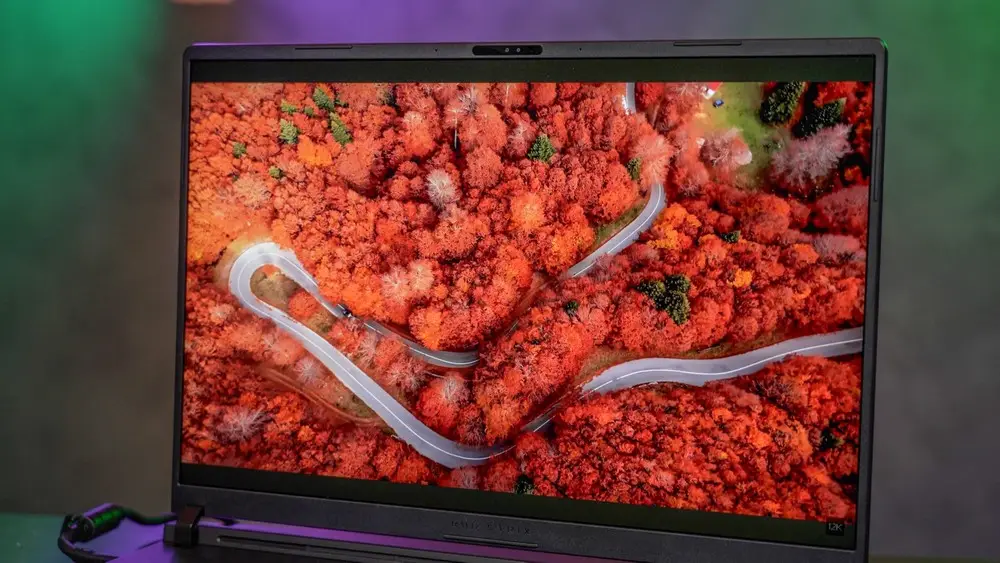
One of this display’s most distinctive attributes is the two backlight modes it can toggle between. First, known as Single Zone, the backlight acts as on a typical IPS display, producing consistent luminance over the complete area. This is the suggested mode for professional designs, all occasions when color consistency and the lack of blooming are needed, and effective application.
Multi Zone, the second approach, is essentially where dimming is turned on. The panel in this mode fully uses Mini LED technology to power over a thousand autonomous zones. Ideal for consuming high dynamic range video content or video games using global illumination and ray tracing, the outcome is extremely high contrast, deep blacks and very dynamic HDR scenes.

The hardware setup of the ROG Strix Scar 18 (2025) is not limited to including highend components: it now represents the best that can be observed in a performancedriven consumer laptop both for gaming and for demanding output. Using these models, Asus sought to provide a real mobile desktop replacement, and it accomplished this by using the most advanced technologies now available from both Intel and Nvidia.
Core Ultra 9 INTEL PROCESSOR
At the top of the Arrow Lake HX architecture (15th generation), the new Intel Core Extreme 9 275HX is the heart of the machine. With a modified design relative to Raptor Lake, this processor uses a configuration of 24 real cores (8 Performance and 16 Efficiency): the latest generation P cores (Lion Cove) no longer support HyperThreading, hence the total number of threads would be 24 instead of the 32 of its predecessors (i913980HX or i914900HX).
The processor runs between 150 and 175W of power in Turbo and Manual modes—extremely high values for a laptop—but that the Scar 18 somehow manages to handle continuously thanks to the new dissipation system. Depending on the energy profile, the performance in Cine bench R23 multicore surpasses 38,000 points, reflecting a 1525 percent rise over the prior generation.
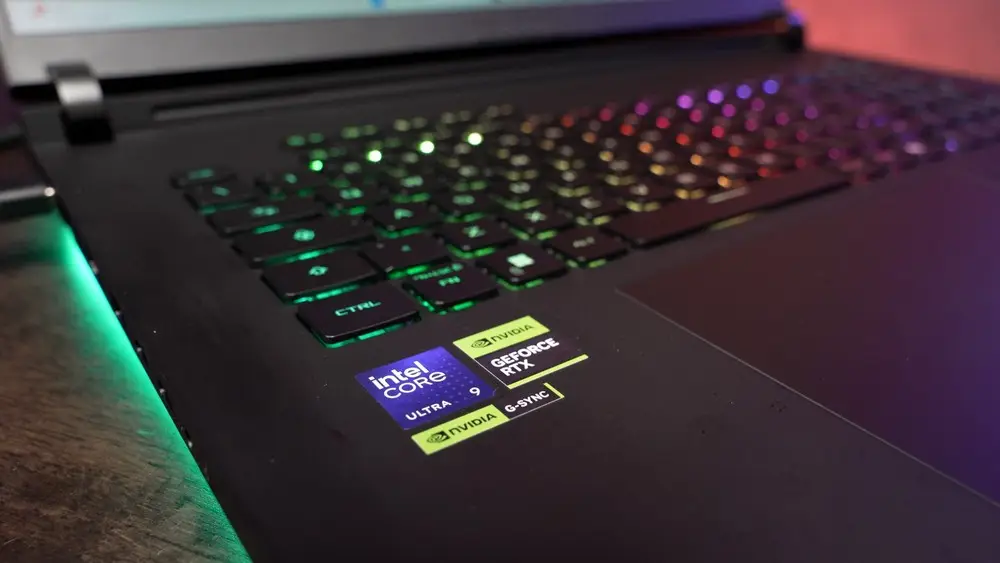
GPU: LAPTOP NVIDIA GEFORCE RTX 5090
Along the processor, Asus has included a mobile variant of Nvidia’s stateoftheline Blackwell chip—the fresh GeForce RTX 5090 Laptop. A GPU with 24GB of GDDR6 VRAM, a maximum TGP of 175W (with Dynamic Boost), and full support of the most recent Nvidia technologies—DLSS 4.0, Frame Generation, Ray Reconstruction, and full path tracing—is it being refers t
The 5090 has an average performance advantage of 1015% in conventional games relative to the RTX 4090 Laptop, but the advantage rises substantially in games that utilize new Nvidia software technologies, such as Cyberpunk 2077 in Overdrive mode or prospective games based on Unreal Engine 5. Moreover, the new GPU is more effective, therefore providing better performance but also lower temperatures for the same power consumption.
This ROG Strix Scar 18 aims mainly to provide a gaming encounter parallel to that of a high-end desktop PC. Using the Nvidia RTX 5090 Laptop GPU and the Intel Ultra 9 275HX processor, Asus guarantees not just great scores in the benchmarks but also fluid playability, great details, and a constant framerate even in the most challenging games. These goals are supported by the field test results, which show performances that let you play even the most recent triple games at greater than 100 frames per second using all Nvidia technology.

The games were tested at native QHD+ resolution (2560×1600), with graphics settings set to Ultra preset or equivalent, Ray Tracing enabled where available, and DLSS set to “Balanced” mode. Without Frame Generation enabled, I ran a first set of games using data from the Scar 18 (2024) with RTX 4090 and those from the Razer Blade 16 used for the 5090 Laptop review and compared the results to those.

I next ran the same group of games with the ROG Strix Scar 2024 and 2025 models, this time with Frame Generation on 2x and later with the frame multiplier on 4x for the 2025 model only. This is how the situation changes:

Finally, I considered a slightly more varied set of titles, somewhat wider. This time I evaluated all the setups against Ultra preset or its equivalent for top possible framerate. Thus, at the highest multiplier feasible for every system, DLSS active and Frame Gen active. And once more you have the following outcomes.
confirms itself as a machine specifically created for the most extreme performances. Actually, in practically every title, it just barely outperforms the Razer Blade 16’s few frames. Still, it is less the outcome reached than the way in which this result is reached. Contrary to the Razer laptop that turned a little oven—it was almost impossible to relax your fingers on some body parts—this Strix Scar 18 always remains relatively warm and, paradoxically, even less noisy despite the extensive size of the dissipation solution and the addition of an extra fan.
And this is exactly one of the key advantages of this answer. Even while engaging the Turbo usage mode, the CPU usually hovers around 80 to 85 degrees C, whereas the GPU remains approximately 70 to 75 degrees C even during long rendering sessions, simulations or intense gaming. For a laptop with this level of hardware, these are superb qualities. The stability of the frequencies is equally satisfactory: there is no throttling even after 3060 minutes of continuous stress, and the clock frequencies remain high, confirming that the cooling system has more than good margins.
freedom of action
And here we are speaking of autonomy , as always a quite sensitive issue in the case of computers of this sort. Since it is also the reference value in highperformance laptops, ROG Strix Scar 18 (2025) has a 90 Wh lithiumion battery—a capacity very close to the maximum allowed for carryon flight shipping but very close to the maximum permitted for carry on flight shipping. This selection is in line with the product’s positioning and exactly what we had in the Strix Scar models of earlier years.
Purely in number terms, this battery provides a range that changes significantly depending on the active energy profile and the kind of load the notebook will be subject to. Assume we cut from roughly 6 hours of use in light production (Word, PDF, Mail, and the like) to about 4 hours of 4K video streaming with Netflix or similar, then to about an hour of gaming or some other kind of activity that demands the laptop to run at its maximum power for an extended period.
Built in two parts, with a long cord ASUS gives a 380W power supply together with a sizable, heavy core block. Really crucial measurements and weight are necessary for a power supply that must be able to bear the maximum load of the system—peak consumption might approach or surpass 250W—or more.
POINTS
In essence, then, the Strix Scar 18 (2025) is a laptop that everyone agrees works well. The development is better, the dissipation at last equals the hardware, and the user experience is more sophisticated though not without some minor ergonomic problems. It is the laptop for those looking for the best without compromises, but which can also become sober when needed. Definitely not for everyone, first and foremost but especially due to the price; our setup will be ready from May at 4999 euros, but those who can pay this sum will rarely find anything more for mobile gaming.
Definitely, I concur; for the usage I get out of the laptop I would probably go with a desktop of notably better performance. Still, you must note that not all customers have the same budget or requirements. If few these people exist, there probably a someone eager to pay this sum for a notepad; since maybe they indeed need a mobile solution ensuring them in this situation the most feasible performance. Otherwise, well, no one is compelling you to buy it; view it as a nice style practice.
advances and setbacks.
best and consistent performance
Great Mini LED Display
Although more sober in design than before, still appropriate for players.
Open and updating simplicity
lacking a SD card reader
The cost is really high.
The sizes are not immaterial.
The finish has quite several fingerprints still visible.



